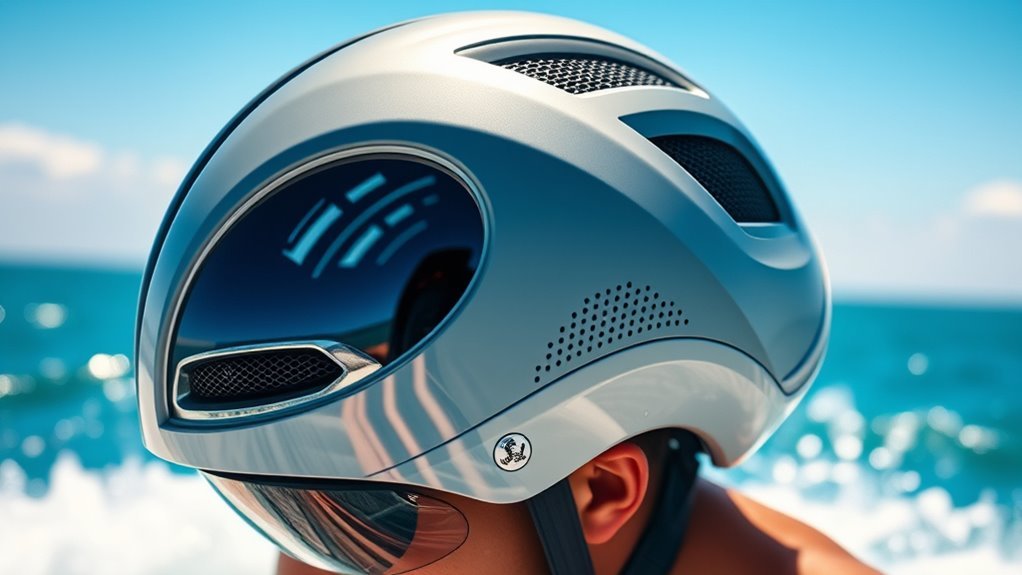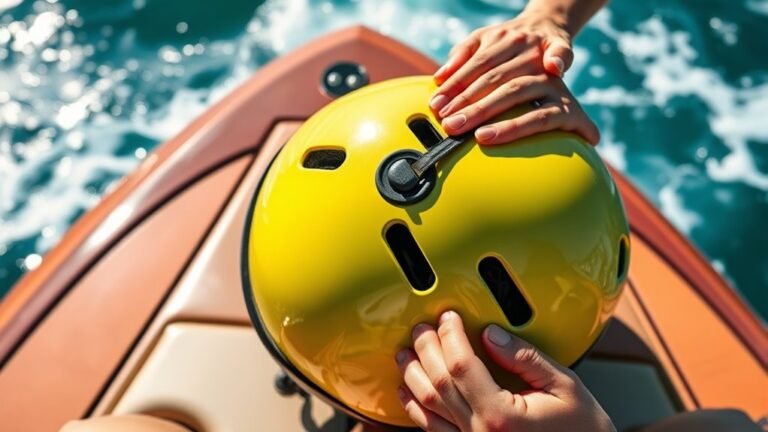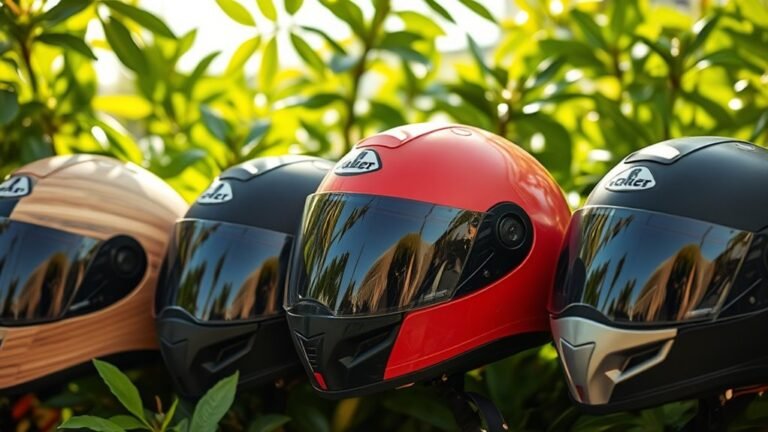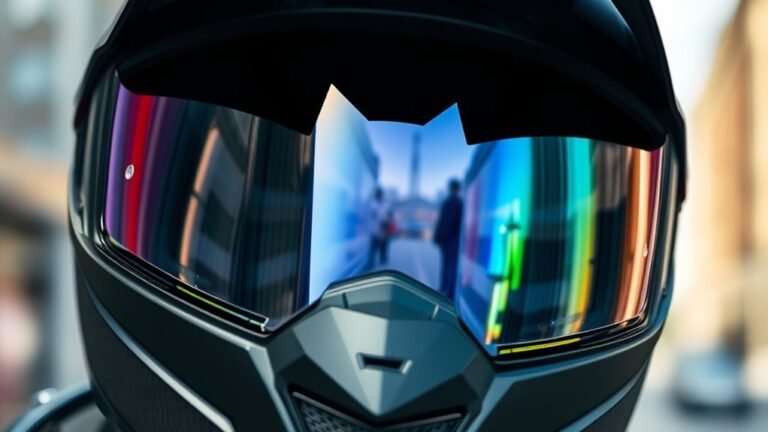Innovations in Helmet Ventilation for Water Sports
Innovations in helmet ventilation for water sports have greatly transformed designs. You’ll find advanced airflow systems that optimize circulation, along with moisture-wicking materials that keep sweat away. Adjustable vents allow you to customize airflow based on conditions, enhancing comfort and focus during activities. Some brands even utilize sensors to adapt ventilation automatically. As these innovations continue to evolve, you’ll discover a blend of functionality and eco-consciousness that elevates your experience. There’s more to uncover about these advancements.
The Importance of Ventilation in Water Sports Helmets
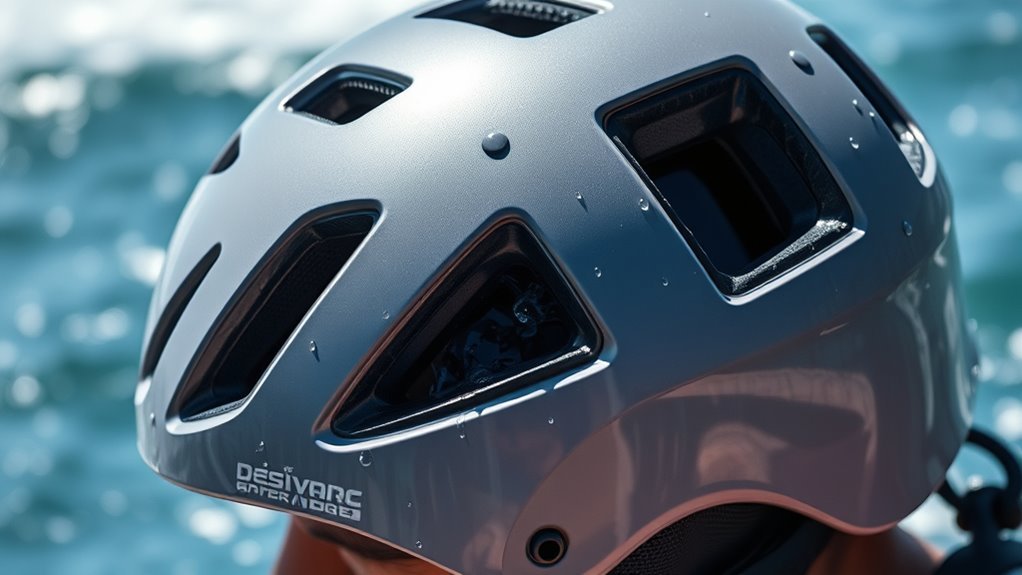
When you’re out on the water, the last thing you want is to feel stifled by your helmet. Effective ventilation is essential for heat management, ensuring that you stay cool and focused during your ride. A well-ventilated helmet not only enhances comfort but also adheres to safety standards, allowing for peak performance without compromising protection. Proper airflow helps prevent overheating, which can lead to distractions and reduced reaction times. Innovative designs incorporate strategically placed vents that maximize air circulation while maintaining structural integrity. You shouldn’t have to choose between safety and freedom; a high-quality helmet balances both. By prioritizing ventilation, you can enjoy your water sports experience fully, pushing boundaries while staying safe and comfortable.
Latest Technologies in Helmet Ventilation
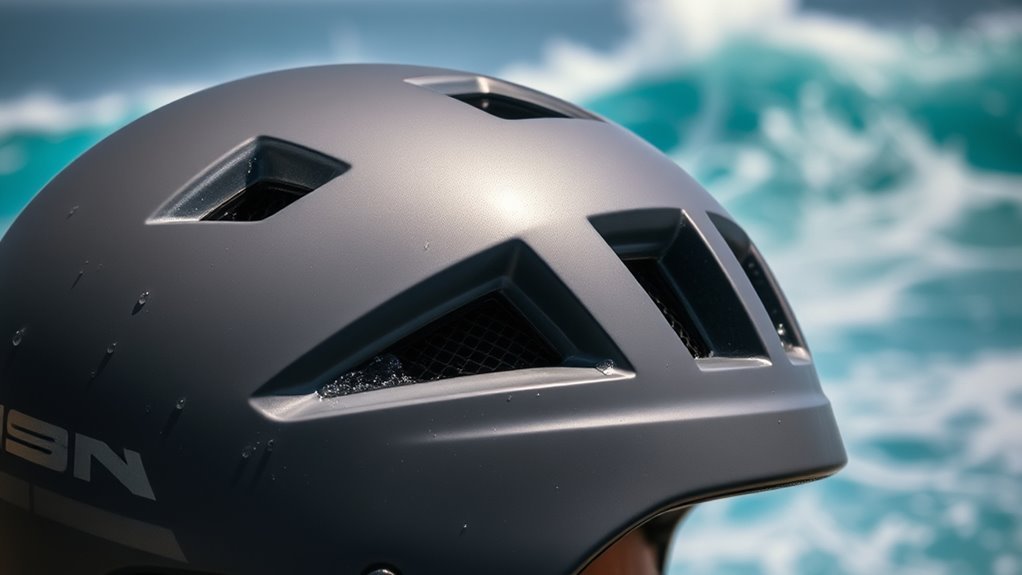
In today’s water sports helmets, advanced airflow systems enhance cooling efficiency by optimizing air circulation. You’ll also benefit from moisture-wicking materials that keep sweat at bay, ensuring comfort during prolonged use. Plus, adjustable ventilation features allow you to customize airflow based on your specific needs and conditions.
Advanced Airflow Systems
As helmet technology advances, integrating advanced airflow systems has become essential for optimizing comfort and safety in water sports. These systems harness innovative airflow dynamics, ensuring a steady stream of air flows through the helmet, which enhances thermal regulation. By utilizing strategically placed vents and channels, heat buildup is minimized, allowing your head to remain cool during intense activities. This technology not only improves comfort but also increases your focus and performance on the water. Additionally, advanced sensors can adjust airflow based on environmental conditions, creating a personalized experience tailored to your needs. With these developments, you can embrace the freedom of movement with confidence, knowing that cutting-edge ventilation keeps you cool and safe while you ride the waves.
Moisture-Wicking Materials
Advanced airflow systems are only part of the equation for enhancing helmet performance in water sports; moisture-wicking materials play an essential role as well. These innovative fabrics are designed to optimize moisture management, keeping you comfortable and focused on your performance.
- Hydrophobic fibers: These materials repel water, guaranteeing sweat doesn’t cling to your skin.
- Breathable membranes: They allow vapor to escape while preventing water ingress, maintaining a dry interior.
- Quick-drying capabilities: This technology guarantees that even after intense activity, your helmet dries rapidly, preventing discomfort and distraction.
With advancements in fabric technology, you can now enjoy unparalleled freedom in your water sports pursuits, knowing that your helmet’s moisture management system works tirelessly to keep you at your best.
Adjustable Ventilation Features
While ideal moisture management is essential, adjustable ventilation features take helmet performance to the next level in water sports. These innovative designs allow you to achieve customized airflow according to your unique preferences and environmental conditions. With user adjustable settings, you can effortlessly fine-tune the ventilation to enhance comfort and reduce heat buildup during intense activities. Advanced mechanisms, such as sliding vents or rotating dials, empower you to control airflow with precision, ensuring that you stay cool and focused. This adaptability not only improves your overall experience but also enhances safety by preventing overheating. Embrace the freedom of tailored ventilation, and discover how these cutting-edge features elevate your performance on the water.
Materials That Enhance Breathability
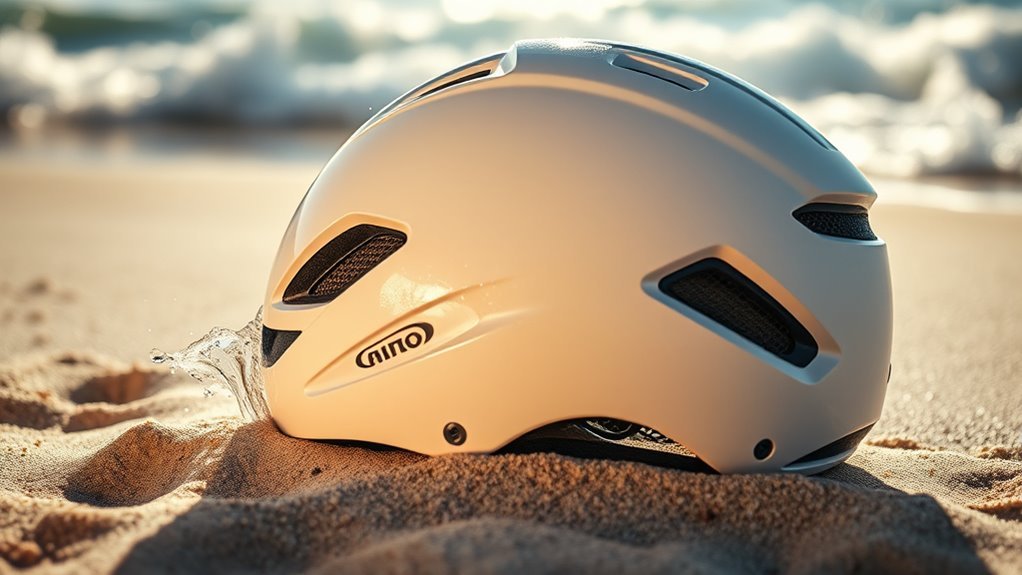
When it comes to helmet ventilation for water sports, the choice of materials plays an essential role in enhancing breathability. You want a helmet that keeps you cool while you’re conquering the waves. Consider these materials:
- Breathable Fabrics: Engineered to allow moisture and heat to escape, these fabrics keep your head dry and comfortable during intense activity.
- Lightweight Composites: Combining strength with minimal weight, these materials guarantee your helmet is durable without sacrificing ventilation or comfort.
- Mesh Panels: Strategically placed for airflow, mesh panels enhance circulation, providing that essential breeze even in the heat of action.
Case Studies: Brands Leading the Way
As helmet design continues to evolve, several brands are pioneering innovative solutions that prioritize ventilation without compromising safety. You’ll find that brand comparisons reveal a range of performance metrics, each showcasing unique approaches to airflow management.
| Brand | Ventilation Technology |
|---|---|
| Brand A | Active cooling channels |
| Brand B | Dynamic airflow vents |
| Brand C | Moisture-wicking linings |
Brand A focuses on active cooling channels for enhanced airflow, while Brand B employs dynamic vents that adapt to conditions. Meanwhile, Brand C incorporates moisture-wicking materials to maintain comfort. Each of these innovations not only enhances performance but also reflects a commitment to freedom on the water. Embrace the evolution—your experience depends on it!
User Feedback: Comfort and Performance Insights
User feedback plays a crucial role in evaluating helmet ventilation systems, as riders often share insights that highlight both comfort and performance. Analyzing user reviews helps manufacturers refine designs to meet user preferences. Here are three key insights from the community:
- Breathability: Riders appreciate helmets with optimized airflow, reducing heat buildup during intense sessions.
- Fit and Comfort: Users emphasize the need for adjustable padding that prevents chafing while ensuring snugness for enhanced safety.
- Performance Under Stress: Many highlight the importance of ventilation systems that maintain cooling efficiency even in high-energy environments.
The Future of Helmet Ventilation Innovations
While traditional helmet ventilation systems have evolved considerably, the future promises even more advanced innovations that will enhance comfort and safety for water sports enthusiasts. Expect helmets crafted from sustainable materials, reducing environmental impact without sacrificing performance. Advanced ergonomic designs will guarantee a snug fit, optimizing airflow while maintaining stability during high-speed activities.
Incorporating smart technology, these helmets may feature adjustable vents that respond to your body temperature and environmental conditions, providing personalized ventilation. Lightweight structures will enhance mobility, allowing you to feel free while maneuvering water challenges. As you embrace these innovations, you’ll experience unparalleled comfort and safety, empowering your adventurous spirit in every wave and rapid. The future of helmet ventilation is bright, promising a harmonious blend of functionality and eco-consciousness.
Frequently Asked Questions
How Do I Clean and Maintain My Water Sports Helmet?
To clean and maintain your water sports helmet, start by removing any removable padding and washing it with mild soap and water. For the shell, use a soft cloth and a gentle cleaner—avoid harsh chemicals. Rinse thoroughly and air dry. Regularly inspect for cracks or wear, as these can compromise safety. Following these helmet cleaning and maintenance tips guarantees your helmet remains in top condition, giving you the freedom to enjoy your adventures safely.
Are There Specific Helmets for Different Water Sports Activities?
Yes, there are specific helmets tailored for different water sports. Surfing helmets are designed to provide impact protection while allowing for ventilation and a snug fit, essential for those riding waves. On the other hand, kayaking headgear often features a more robust design to withstand rough conditions and impacts from obstacles. Each helmet type optimizes safety and comfort, ensuring you can enjoy your passion while staying protected and free in the water.
Can Ventilation Affect Helmet Safety Ratings?
Yes, ventilation can indeed affect helmet safety ratings. In fact, studies show that helmets with advanced ventilation design can improve comfort and cooling, potentially leading to better focus and performance during activities. However, it’s essential to guarantee that these designs don’t compromise structural integrity, as safety standards prioritize impact resistance. Balancing effective airflow with robust protection is key to maintaining both safety and freedom while enjoying your water sport adventures.
What Is the Average Lifespan of a Ventilated Helmet?
The average lifespan of a ventilated helmet typically ranges from 3 to 5 years, depending on helmet materials and usage. High-quality materials like polycarbonate and fiberglass can enhance durability, while frequent exposure to harsh conditions may shorten this lifespan. It’s essential to inspect your helmet regularly for any signs of wear or damage. By prioritizing maintenance, you can guarantee your helmet continues to perform effectively, giving you the freedom to enjoy your water adventures safely.
How Do I Choose the Right Size for Optimal Ventilation?
To choose the right size for ideal ventilation, start by measuring your head circumference accurately—about 70% of users wear the wrong size. Use fitting techniques like trying on multiple helmets and adjusting the straps to guarantee a snug fit without pressure points. A well-fitted helmet allows for better airflow, enhancing comfort during water sports. Don’t compromise on size; it’s essential for both safety and ventilation performance while you enjoy your freedom on the water.
